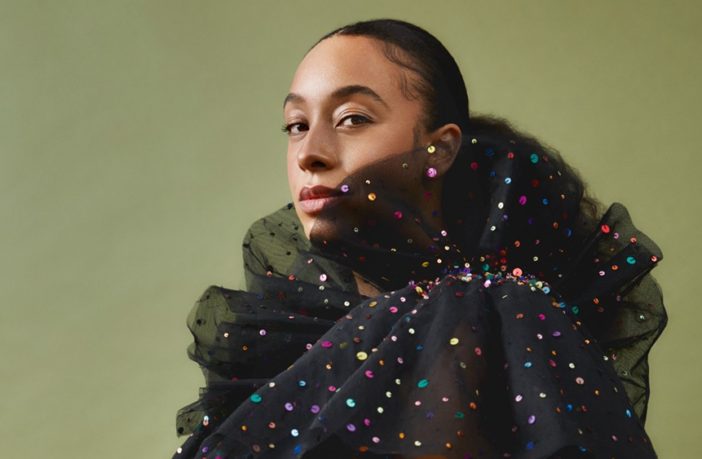EBONY is always “Moving Black Forward.” So we weren’t surprised to learn that Black Rainbows, Corinne Bailey Rae’s first album in seven years—out September 15—was inspired by the EBONY archives at the Stony Island Arts Bank in Chicago.
Best known for her 2006 Grammy-nominated hit “Put Your Records On,” Rae did a deep dive inside the Arts Bank, a 17,000-square-foot space devoted to innovation in contemporary art and archival practice.
There, she immersed herself in the Johnson Publishing Company collection of books and periodicals donated by John H. and Eunice Johnson, the founder and executives of EBONY and JET magazines. The space was also the in-house library once used by JPC editors and writers.
The tracks on Black Rainbows reflect the faces and stories Rae discovered in her research and how America’s beautiful and haunting history has impacted this English-born and bred singer-songwriter. Here, she shares her inspiration.
EBONY: This is your first album in seven years. Why was now the right time for new music?
Corrine Rae Bailey: EBONY was instrumental in the making of this record. It was the archive of all the books that EBONY founders Mr. and Mrs. Johnson collected, and I encountered all these amazing and problematic objects from America’s historical past. When I left, all I could think about were those objects, pictures and faces in photographs, bits and scraps of stories I had read and newspaper articles I had opened. I wanted to go back and learn more. It has been a long process and for each question I had, it led to 10 more questions, which led to many more galleries, exhibitions and libraries. So, it’s been a combination of years of research. I also had two children.
How did you discover the Stony Island Arts Bank?
I saw a photograph on a friend’s Pinterest board about creatives and their workspaces and a picture of the artist Theaster Gates. This man was staring out from this photograph with all his contemporary art around him: a pile of bricks here, a goat with spindly legs going around on a train track, a picture outside Harold’s Chicken sign chasing a chicken with a cleaver. I wanted to know this Black man who makes this art and knows it to be art. I learned about the Rebuild Foundation and all the artist-led transformation happening in the Southside of Chicago. Theaster came to one of my shows in the city and took me to the Arts Bank the next morning. I knew I wanted to come back and see more.
How did you land upon Black Rainbows as the title of your first album in seven years?
I liked the idea of a rainbow as a very wide spectrum. I like the idea that blackness contains all the colors. The Arts Bank offers a diverse range of Black thinking, which isn’t homogenous. The library has information that goes back to the 1800s and spans all these political opinions. From that to future utopian Black spaces, these dialogues bounce back and forth through history. Whether the future of the African diaspora and its people is to be separate and away or to recognize that we are here in these different spaces to integrate and to allow other communities to influence ours and for our communities to influence others, the rainbow title partly refers to this wide range of spectrum of blackness and Black thinking.
And what about the music itself?
The album is very diverse from song to song. I wanted to use all these styles: psychedelic, jazz, punk and synth. There is dance music and experimental and traditional. I wanted to be able to explore my fuller range and my different colors.
You based your song “Peach Velvet Sky” on the real-life story of Harriet Jacobs. What drew you to her story?
I came across the story of Harriet Jacobs in a book that my aunt sent me when I was a teenager, and it shared her life as an enslaved girl. The complicated story of this woman struck me. Her enslaver, a violent man, pursued her, but he was also a family doctor and a surgeon. She’s trying to get away from him but knows if she goes north, he’ll pursue and find her, and the consequences of her being brought back will be terrible for her and her children. She comes up with the idea of hiding on the plantation, hiding exactly where he thinks that she won’t be, in a crawl space above her free grandmother’s storeroom. She’s carved this hole in the side of the building so she can look out and see her children growing up over seven years. I just thought this is such an incredible story, and it’s so hard to believe, but it’s factually true. Just the mental resilience of a woman to sustain this, to have the major players in your life coming and going past where you are and not knowing, and the feeling of isolation she’s built up. When she became free, she worked to free other people, became an educator and a civil rights campaigner, and looked after refugees during the Civil War. I think she had an incredible life, and getting to a literacy level where she can offer her own story is amazing.
You express her freedom via dance in your video.
The song came about when I was thinking about sunsets—what does it look like from Harriet Jacobs’ hiding place and what did it look like when she was free? How wide was the horizon? How bright were the colors? I thought that the contrast between confinement and freedom was interesting to explore.
What’s the inspiration behind the song “New York Transit Queen,” which has a real punk vibe?
I saw this amazing photo in an old copy of EBONY Magazine. Audrey Smaltz won the Transit Queen competition in 1954 when she was 17. Since other competitions weren’t readily open to Black women, the Black transit workers, one of the biggest unions in the country, got together and said, we’re gonna have our own competition. I saw this picture in EBONY and thought, “Who is she?” She seems so cool, and she’s an artist. I’d seen many 1950s pictures of white women in bathing suits, but I’d never seen a Black woman pose that way. I then found out that she was the right-hand woman for Mrs. Johnson. They would fly to Paris for clothes and return them for the EBONY fashion fair show. Audrey was the show’s announcer.
You explore many themes of Black female empowerment in this album.
I wanted to celebrate all these Black women’s stories. Looking through those archives and seeing a particular historic moment, I realized many of these women were celebrated in their own time. But if that chain is broken, where we don’t pass on that information to the next generation, it’s like it didn’t happen. Their stories have been silenced, erased or forgotten, deliberately obfuscated, discredited, or told that they’re untrue. I was amazed to find the stories and furious that I didn’t know about them sooner.
If you had to use one word to describe how your music has evolved, what would it be?
I think freedom is a really good word. It’s meant that I can focus on a wider range of things, not just my thoughts, feelings and experiences, but what is around me and what interests me. And also the freedom to explore all these different styles and the spectrum of emotion, to bring in anger and joy, to bring in despondency and healing. Freedom is important.
Black Rainbows is available on Amazon.


